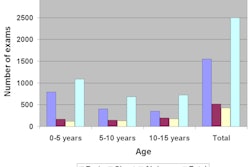Developing a viable treatment program for elderly cancer patients often requires as much attention paid to the logistics of treatment as to the treatment itself. A radiation therapy program that may be optimal for treatment of a patient may not be realistic to implement if mobility, social support, or transportation issues interfere.
Results of a clinical study at the Institut Curie in Paris verify that patients with nonmetastatic breast cancer can achieve the same long-term outcomes with conservative surgery followed by high-frequency (HF) radiotherapy administered once a week as patients who receive conservative surgery followed by daily radiation therapy. A once-weekly treatment regimen may be more practical and achievable for elderly patients who may require assistance leaving their home to go to a cancer treatment center or who may be challenged by the logistics of transportation.
Patients over 65 years of age represent 40% to 50% of new breast cancer cases in economically developed countries. Because women over age 70 are generally excluded from clinical trials, data about long-term local control and survival outcomes have not been well documented, stated Dr. François Campana, a radiation oncologist who presented the Institut Curie's findings at the 50th annual meeting of the American Society for Therapeutic Radiology and Oncology (ASTRO).
Between 1995 and 1999, 401 patients 70 years of age and older were treated for breast cancer at the Institut Curie. All had lumpectomies and lymph node dissection, followed by radiation therapy.
Three hundred forty-seven patients received a total normal-frequency (NF) radiotherapy dose of 50 Gy in 25 fractions to the breast, administered daily for five weeks. These patients also received irradiation to the lymph nodes. Sixty-four percent of patients in this group were between 71 and 79 years of age, and 36% were ages 80 and older.
Fifty-four patients, 87% of whom were older than 80 years of age, for whom daily radiation was not feasible, received high-frequency radiotherapy in 6.5 Gy fractions delivered once weekly for a total dose of 32.5 Gy. RH-positive patients took 20 mg of tamoxifen daily.
Patients were followed between nine and 143 months, with a median follow-up of almost eight years (92 months). Campana reported that the cause-specific survival at five years was 96% for the NF group and 93% for the HF group; statistics also were comparable at 10 years between the groups: 89% for NF and 85% for HF.
There were no significant differences between the groups for cancer-specific survival, no metastatic disease was found at five and 10 years in either group, and treatment tolerance and cosmetic results were comparable between the two groups of patients. Both therapies were highly effective.
"While large randomized clinical trials are needed to confirm our results, we are now able to tell our patients that HF radiation therapy provides long-term local control and is an acceptable alternative, producing equivalent results to daily NF radiation therapy," Campana said.
By Cynthia Keen
AuntMinnie.com staff writer
October 30, 2008
Related reading
Mammography benefits have no age limit, April 22, 2008
Radiotherapy can benefit elderly women with early breast cancers, May 17, 2006
Breast cancer may be undertreated in octogenarians, May 15, 2006
Distance from radiation therapy facility affects breast cancer treatment, November 29, 2005
Copyright © 2008 AuntMinnie.com


















